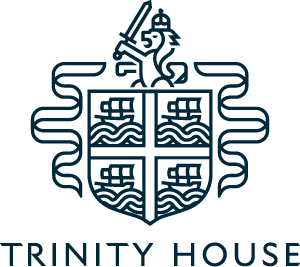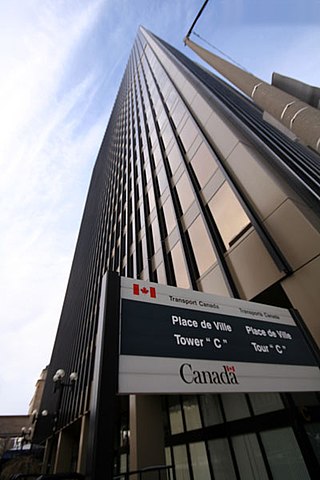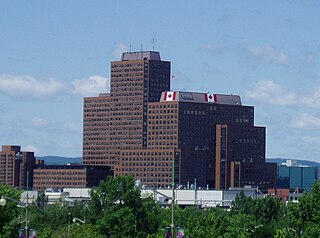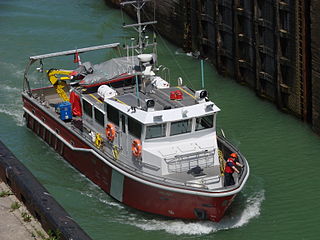
The Corporation of Trinity House of Deptford Strond, also known as Trinity House, is the official authority for lighthouses in England, Wales, the Channel Islands and Gibraltar. Trinity House is also responsible for the provision and maintenance of other navigational aids, such as lightvessels, buoys, and maritime radio/satellite communication systems. It is also an official deep sea pilotage authority, providing expert navigators for ships trading in Northern European waters.

Laurentian University, officially Laurentian University of Sudbury, is a mid-sized bilingual public university in Greater Sudbury, Ontario, Canada, incorporated on March 28, 1960. Laurentian offers a variety of undergraduate, graduate-level, and doctorate degrees. Laurentian is the largest bilingual provider of distance education in Canada.

The minister of transport is a minister of the Crown in the Canadian Cabinet. The minister is responsible for overseeing the federal government's transportation regulatory and development department, Transport Canada, as well as Canada Post, the Saint Lawrence Seaway, Nav Canada, and the Port Authority system. Since 26 July 2023, the position has been held by Pablo Rodriguez of the Liberal Party.
The Laurentian Bank of Canada is a Schedule 1 bank that operates primarily in the province of Quebec, with commercial and business banking offices located in Ontario, Alberta, British Columbia, and Nova Scotia. LBC's Institution Number is 039.

Transport Canada is the department within the Government of Canada responsible for developing regulations, policies and services of road, rail, marine and air transportation in Canada. It is part of the Transportation, Infrastructure and Communities (TIC) portfolio. The current Minister of Transport is Pablo Rodriguez. Transport Canada is headquartered in Ottawa, Ontario.

The Canadian Air Transport Security Authority is the Canadian Crown Corporation responsible for security screening of people and baggage and the administration of identity cards at the 89 designated airports in Canada. CATSA responds to Transport Canada and reports to the Government of Canada through the Minister of Transport.
.gc.ca is a privately held second-level domain in the .ca top-level domain. It is used by the Government of Canada and operated by Government Telecommunications and Informatics Services, which holds all third level domains under the .gc.ca banner.

A maritime pilot, marine pilot, harbor pilot, port pilot, ship pilot, or simply pilot, is a mariner who has specific knowledge of an often dangerous or congested waterway, such as harbors or river mouths. Maritime pilots know local details such as depth, currents, and hazards. They board and temporarily join the crew to safely guide the ship's passage, so they must also have expertise in handling ships of all types and sizes. Obtaining the title "maritime pilot" requires being licensed or authorised by a recognised pilotage authority.

The Port of Churchill is a privately-owned port on Hudson Bay in Churchill, Manitoba, Canada. Routes from the port connect to the North Atlantic through the Hudson Strait. As of 2008, the port had four deep-sea berths capable of handling Panamax-size vessels for the loading and unloading of grain, bulk commodities, general cargo, and tanker vessels. The port is connected to the Hudson Bay Railway, which shares the same parent company, and cargo connections are made with the Canadian National Railway system at HBR's southern terminus in The Pas. It is the only port of its size and scope in Canada that does not connect directly to the country's road system; all goods shipped overland to and from the port must travel by rail.

Sailing Directions are written directions that describe the routes to be taken by boats and ships during coastal navigation and port approaches. There are also products known as Sailing Directions, which are books written by various Hydrographic Offices throughout the world. They are known as Pilot Books, because they provide local knowledge of routes and landmarks, which would typically be provided by a local marine pilot. As such, they are used frequently by naval and government vessels, who are exempted from 'Compulsory Pilotage' in many ports.

The Canadian Transportation Agency is the independent, quasi-judicial tribunal of the Government of Canada that makes decisions relating to federally-regulated modes of transportation. Its headquarters are in the Jules Léger Building (South) in Terrasses de la Chaudière, Gatineau, Quebec.
The Atlantic Pilotage Authority Canada is a Crown corporation of the Government of Canada, which was established as a result of recommendations made by the Royal Commission on Pilotage in Canada, by the Pilotage Act, Section 18, on February 1, 1972 mandated to assist in pilotage in all Canadian waters in and around the provinces of New Brunswick, Prince Edward Island, Nova Scotia and Newfoundland and Labrador.

ABCO Industries is located on the waterfront of the UNESCO World Heritage Site-designated port town of Lunenburg, Nova Scotia.

The United Kingdom's Pilotage Act 1987 is an Act of Parliament that governs the operation of maritime pilotage. The Act repealed the previous pilotage legislation in its entirety, the Pilotage Act 1983, which itself had repealed the Pilotage Act 1913.

A Bristol Channel pilot cutter is a type of sailing boat used until the early part of the 20th century to deliver and collect pilots to and from merchant vessels using ports in the Bristol Channel. Each pilot worked individually, in competition with other pilots. Especially after 1861, the level of competition required larger and faster cutters, as pilots went "seeking" at much greater distances. The resulting boats were known for their ability to sail in the most extreme weather, for speed and sea-kindliness. They were designed for short handed sailing, often manned only by a man and an apprentice, with one or sometimes two pilots on board.
The Canada Marine Act was passed in 1998 under the stewardship of David Collenette, who was Canada's Minister of Transport at that time. It was intended to modernize Canada's most important ports and make "the system of Canadian ports competitive, efficient and commercially oriented, providing for the establishing of port authorities and the divesting of certain harbours and ports, for the commercialization of the St. Lawrence Seaway and ferry services and other matters related to maritime trade and transport and amending the Pilotage Act and amending and repealing other Acts as a consequence."

Seaforth Channel is a channel in the Central Coast region of the Canadian province of British Columbia which is part of the Inside Passage - the 950 miles (1,530 km) passage between Seattle, Washington and Juneau, Alaska. The marine highway goes through Seaforth Channel on the way to Milbanke Sound, one of the open sea portions of the Inland Passage. Seaforth Channel which is part of the Prince Rupert/Port Hardy BC ferry route, extends in a westerly direction from Denny Island to Milbanke Sound between Denny Island, Campbell Island and the Wright group of islands on the south. In October 2016, a Texas-owned tug/barge transiting the Canadian waters of the Inside Passage without a local pilot was hard grounded on a reef at the entrance to Seaforth Channel in October 2016. More than 100,000 L of fuel contaminated the coast, coves and shores 20 km (12 mi) west of Bella Bella, the core community of the Heiltsuk Nation as well as the environmentally sensitive Great Bear Rainforest - Canada's contribution to the Queen's Commonwealth Canopy (QCC), a network of forest conservation programs. Clean up response and salvage was criticized by the Heiltsuk, B.C. Premier Christy Clark and Prime Minister Justin Trudeau. In November in Vancouver the Prime Minister announced a $1.5B ocean protection plan to "create a marine safety system, restore marine ecosystems and undertake research into oil spill cleanup methods."

St. Lawrence Estuary stretches from west to east for 655 km, from the outlet of Lake Saint Pierre to pointe des Monts, where it becomes the Gulf of St. Lawrence, in Quebec, Canada.
The Great Lakes Pilotage Authority is a Crown corporation of the Government of Canada, which was established as a result of recommendations made by the Royal Commission on Pilotage in Canada, by the Pilotage Act in February 1972. Initially incorporated as a limited company in May 1972, it became an independent Crown corporation in 1998. The corporation is responsible for pilotage through Canadian waters in Manitoba and Ontario, as well as waters in Quebec south of the Saint-Lambert Lock. In international waters, pilotage is a shared responsibility between the Great Lakes Pilotage Authority and American pilot associations.
The Pacific Pilotage Authority is a Crown corporation of the Government of Canada that is responsible for pilotage through coastal waters in British Columbia, including the Fraser River.














